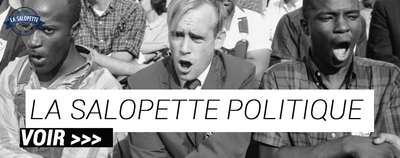La Salopette de coluche or even James Dean brooding. Dusty gold miners and smooth hair greasers with cigarette boxes rolled up in their T-shirt sleeves. The history of bluejean overalls is about as American as that of apple pie, with working-class origins and a pioneering spirit.
But do you know what the "All-American" is? Getting thrown the special lunch of the week at a counter sit-in, facing a raised baton at a protest march , and walking a mile and a half to work because your civil rights boycott hit the bus, all while wearing those same hemmed jeans pants . The only difference is that the story likes to tell the scenes of Gold Rush camps and Route 64 rides, when talking about the past of denim overalls , it's not often you hear about the freedom fighters who in large part helped bring this look to fame.
For example, in 1969 nearly 200 students were suspended from their high schools for wearing dark blue overalls because they looked too much like blue jeans . It was mostly an item of clothing to be worn for cleaning the garage, not for going out for a cocktail. Often associated today with clothing for work, work dungarees fit perfectly with the fashion spirit of the 90's but also join the spirit of modern fashion, thanks to sophisticated and ever more attractive manufacturing and designs.
The headline-grabbing revolutionaries helped denim overalls become a wardrobe staple for everyday people. "It took Martin Luther King 's march on Washington to make them popular. It was here that civil rights activists were pictured wearing the poor sharecropper's blue denim overalls to dramatize what little had been accomplished since Reconstruction ".

If, at first, activists put on their overalls for convenience - they were tired of suffering the beatings of batons and the fangs of police dogs, denim overalls could withstand such abuse - they also donned them to bring to life a not-so-distant past. They were called "nigger clothes" - slave owners bought denim for their enslaved workers, in part because the material was strong and cheap compared to the linen or silk the merchants brought back from their journeys. The denim could be kept for several years and did not require any particular treatment.
The inclusion of denim overalls in the civil rights movement suggested that there was a clear social divide here. For much of the black community, the symbolism of activists was obvious. Separated then, reunited today. This garment united both the past and the world of today. Protester, overalls have since become more than legendary !

"Some African Americans felt that wearing denim overalls was disrespectful to oneself," says James Sullivan . "For many African Americans, denim work clothes represented a painful reminder of the old sharecropping system. James Brown , for example, refused to wear denim overalls and for years forbade members of his band from wearing them". Sullivan points out that if you look at the pictures of the sons and daughters of the early 20th century generations of sharecroppers who moved north away from the fields, you'll notice they wore suits , ties and hats for their factory jobs, in part to create that distance.
"It took Martin Luther King's march on Washington to make them popular...civil rights activists were photographed wearing the poor tenant farmer's blue denim overalls to emphasize how little had been accomplished since Reconstruction."
Although some protesters knew their white neighbors would resent seeing them marching through the streets in tenant-farming attire - they used this to their advantage - the strategy was not promoted by all freedom fighters. The politics of respectability was always a popular tactic for gaining support. In 1965, before preparing to descend on three segregated states in the Deep South to get people on the ballot, an NAACP representative walked to the front of the room at a secret civil rights meeting in New York and said bluntly, "We don't want girls in blue jeans. We don't want boys in beards."
They wanted people's hair ironed and collars crisp, knowing that the evening news would quickly misrepresent them if they didn't come in their Sunday attire. It was necessary to maintain a respectable image, of integration, of discretion, without verbal or stylistic provocation.

But the responsibility of always looking respectable was not just a strategic move, but a burden imposed on activists in order to keep white supremacists away from their front door. Indeed, white supremacists would specifically attack the moral character of black women to justify separating their neighborhoods and having their polling places white. Black women had to go above and beyond to prove their respectability in order to protect their character, as well as the men and children of their community. By looking like a woman who could bake a French-style cake, black women were able to show off their Christian good manners , breaking away from the racist stereotypes their white neighbors were trying to pin on them. Jeans were not an option.
- It wasn't just for comfort and durability. To register to vote as a black person was to risk losing your job , or worse, your life by inviting the Klu Klux Klan into your backyard. The fear was evident in the statistics—in Mississippi , less than 7 percent of the eligible black population was on the voter rolls, and in many rural southern counties there were none at all . And now these student groups, like the Student Nonviolent Coordinating Committee, were trying to convince black farmers to risk it all, handing them a clipboard while wearing dodgy moccasins. This created a divide between the classes, and the men in blue overalls were not only the language that would bridge the gap between them, but also their show of solidarity .
More so, by donning workers' uniforms , revolutionaries showed that they did not need to dress in a way deemed "acceptable" by their white peers to gain the rights that were theirs to begin with . Even if the militants presented themselves with banker stripes, that would not convert the segregationists into allies. "No matter what white people's sense of justice tells them to do for black people, will they be bulldozed into doing it?" asked the Leader of the Missouri Springfield and Press in 1967. White people refused to be 'pushed' into equality. Movement clothing was not the problem, and having their appearance controlled was just another way of being controlled .
Denim was very close to the struggle for black freedom , but like most contrarian messaging – from anti-establishment punks with their queen tartan to anti-capitalist beatniks with their berets – it was co-opted into the mainstream; taken out of its original context to fit into people's clothes. But unlike those well-known and heavily referenced underground movements, most people don't know what types of denim overalls were copied from civil rights protesters . Instead, these same types were recognized as "new" or "vintage". In reality, these mythical garments carry a history loaded with symbolism and controversy.
"The trucker code that Levis introduced in the '60s, during the height of the hippie era, was actually a throwback to the style of denim jackets that working class and sharecroppers have worn for decades," Sullivan explains. What we now consider the classic Levis jacket was introduced as a new style in 1962, but poor sharecroppers in the Deep South have been wearing it for decades.

"If it was cold enough to wear a jacket, they wore overalls or jeans , then a farmer's jacket over them. Sharecroppers' connection to the rural, back-to-the-land working class inspired, in part, the all-denim, top-to-bottom look that the hippies came to wear".
The hippies wanted to be "salt of the earth" with their townships and community farms, but for the black sharecroppers, style was a function of poverty , not fashion - it couldn't be taken away so easily. But the look caught on and soon every high school student and suburban dad was going for the style.
While the history of blue jeans has its roots in dude ranches and country dance halls, it is also set in the struggle for equality and racial justice . It is an era as important and American as the Wild West . Not only did the ranchers wear denim jackets , but also the black sharecroppers; not only the cowboys lived in their jeans, but the slaves in the fields; and it wasn't just truckers in overalls driving Route 66 at night, but also civil rights icons with positive actions that made history. History as a whole will have to retain this fraction of activist who will forever anchor the place of black Americans in the breasts of American society! 🇺🇸

